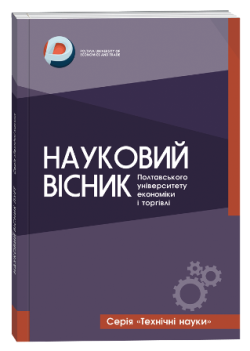FORMATION OF SAFETY INDICATORS FOR ORGANIC FLOUR CONFECTIONERY PRODUCTS
Abstract
Abstract. The article examines the peculiarities of forming a safety indicator system for organic flour confectionery products, taking into account the specifics of organic production. The main hazardous factors affecting product quality and safety at all stages of the technological process are analyzed. Four main risk groups have been identified: biological, chemical, physical, and allergenic factors. The highest level of danger (K = 0.9) was found at the stages of raw material preparation, heat treatment, and packaging. Biological hazardous factors of organic raw materials have been systematized, including pathogenic microorganisms (Salmonella spp, Campylobacter spp, L. monocytogenes, Staphylococcus aureus, Bacillus cereus) and mycotoxins (aflatoxin, ochratoxin, deoxynivalenol). Key differences in risk minimization in organic production have been determined: limited list of permitted disinfectants, increased contamination risk due to antibiotic prohibition, special raw material processing requirements. Critical storage parameters to prevent toxin-producing fungi development have been established. A detailed analysis of allergenic factors was conducted, including thermostable egg proteins, flour gluten, milk proteins, and nuts. Minimum acceptable levels of allergen traces and labeling requirements have been substantiated. The developed risk assessment methodology based on probability of occurrence and severity of impact criteria allows effective ranking of hazardous factors. The absence of significant differences in microbiological stability between organic and non-organic products has been proven. The research results have practical significance for developing regulatory and technical documentation, implementing HACCP systems in organic production, and enhancing the competitiveness of domestic organic products.
References
2. Лозова Т. М., Сирохман І. В. Наукове обґрунтування поліпшення споживних властивостей борошняних кондитерських виробів з використанням природної нетрадиційної сировини [Текст] : монографія. Цетр. спілка спожив. т-в України, Львів. торг.-екон. ун-т. Львів : Вид-во Львів. торг.-екон. ун-ту, 2017. 327 с.
3. Хомич Г. П., Бородай А. Б., Горобець О. М. Дослідження якісних показників борошняних виробів з хеномелесом в процесі зберігання. Науковий вісник Львівського національного університету ветеринарної медицини та біотехнологій імені С. З. Ґжицького. Серія : Харчові технології. 2016. Т. 18, № 1(4). С. 143–148.
4. Дорохович А. М., Лазоренко Н. П. Маффіни на безглютеновому борошні для хворих на целіакію. Ukrainian Food Journal. 2012. № 1. С. 58–61.
5. Дорохович В. В. Перспективи розроблення органічних борошняних кондитерських виробів спеціального призначення. Хлібний та кондитерський бізнес. 2021. № 2. С. 24–26.
6. Іоргачова К. Г., Макарова О. В., Котузаки О. М. Бісквітні напівфабрикати на основі борошна з продуктів переробки гречки. Зернові продукти і комбікорми. 2010. № 4(40). С. 12–15.
7. Пересічний М. І. Технологія продуктів харчування функціонального призначення : монографія. К., 2008. 717 с.
8. Капліна Т. В., Столярчук В. М., Кудрик М. А. Вплив композиційної борошняної суміші з гарбузового насіння та гречки на показники якості кексів. Наукові праці ОНАХТ. 2012. Вип. 42. Т. 1. С. 178–181.
9. Оболкіна Віра Іллівна. Наукове обґрунтування та розроблення раціональних технологій комбінованих кондитерських виробів, які формуються методом ко-екструзії [Текст] : автореф. дис.... д-ра техн. наук: 05.18.01. Київ : Нац. ун-т харчових технологій, 2006. 40 с.


